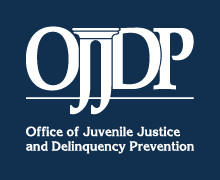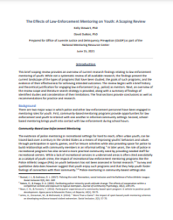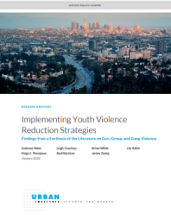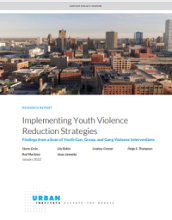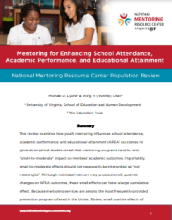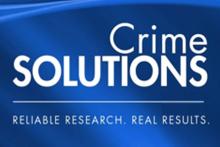Literature Reviews
Mental Health: The Influence of Mental Health on Juvenile Justice System Involvement
Status Offenses
A status offense is a nondelinquent (and noncriminal) act that is illegal for underage individuals (usually age 17 or younger), but not for adults. There are five main types of status offenses: 1) truancy, 2) running away from home, 3) violating curfew, 4) violating underage liquor laws, and 5) ungovernability. Tobacco offenses and a variety of other acts may also be regarded as status offenses...
Children's Advocacy Centers
Model Programs Guide Literature Review: Youth Curfews
Youth Curfews
Youth curfews are an example of a local policy response to crime and delinquency committed by youths or to an increase in incidents of victimization of youths. While the requirements and restrictions vary by time, place, and age (Hazen and Brank, 2018), the general concept is that keeping youths at home during the late-night to early morning hours will limit their opportunities to commit or...
Credible Messenger And Lived Experience Mentoring Programs, Evidence Review
Alternatives to Detention and Confinement
Gun Violence and Youth/Young Adults
Age Boundaries of the Juvenile Justice System
The juvenile justice system has evolved though four periods since the juvenile courts’ creation more than a century ago: the Progressive Era (1899–1960s), the Due-Process Era (1960s and 1970s), the Get-Tough-on-Crime Era (1980s and 1990s), and the contemporary reaffirmation of the Kids-Are-Different Era (2005 to the present) [Luna, 2017; National Research Council, 2013]. The juvenile justice system evolved to hold youths who offend accountable for...
Finding an answer in time: Assessing change in needs scores on time to recidivism among justice-involved youth
Bullying and Cyberbullying
Bullying involving children and youth has become a topic of national conversation over the past few decades and is a major focus for schools across the United States and internationally (Gladden et al., 2014; Ybarra et al., 2019). Bullying can cause substantial harm to the children and youth who are victimized, to those who engage in bullying behaviors, and to the bystanders who witness bullying...
Literature Review: Community-Oriented Policing and Problem-Oriented Policing
In 1979, Hermon Goldstein observed from several studies conducted at the time on standard policing practices that law enforcement agencies seemed to be more concerned about the means rather than the goals of policing. He argued that law enforcement agencies should shift away from the traditional, standard model of policing and that police become more proactive, rather than reactive, in their approaches to crime and...
The Effects of Law-Enforcement Mentoring on Youth: A Scoping Review
Implementing Youth Violence Reduction Strategies: Findings from a Synthesis of the Literature on Gun, Group, and Gang Violence
Implementing Youth Violence Reduction Strategies: Findings from a Scan of Youth Gun, Group, and Gang Violence Interventions
Mentoring for Enhancing School Attendance, Academic Performance, and Educational Attainment
Virginia: An Assessment of Access to Counsel and Quality of Representation in Delinquency Proceedings
Disproportionate Minority Confinement: A Review of the Research Literature From 1989 Through 2001
Evidence-based Programs
The Office of Juvenile Justice and Delinquency Prevention (OJJDP) encourages the use of evidence-based programs and practices. Evidence-based programs and practices generally have one or more rigorous outcome evaluations that demonstrated effectiveness by measuring the relationship between the program and its intended outcome(s). This includes measuring the direction and size of a change in outcome and the extent to which a change may be attributed...




